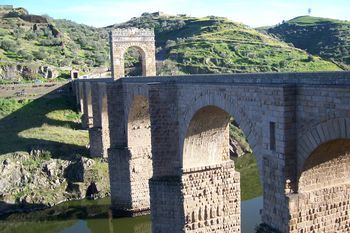Ancient Roman Bridges
Connection between cities, ports, mines and neighboring civilizations brought the need of creating stable and permanent roads. For this purposes, many ancient civilizations started to leave their mark on history buy leveling up uneven terrain, forging their way through wilderness and eventually, bridging rivers and extreme land formations with wood logs and stones. These early bridge building efforts finally received massive update in Greece, where builders and mathematicians discovered new ways of molding the weight of bridge material into structures that could remain strong enough to carry incredible weights.
With the arrival of Roman Empire, bridge building techniques were revolutionized with the introduction of arches. Rather than crudely covering entire surface below the deck of the bridge with the stone or wood, architects of that time built their bridges with the arching shapes, enabling downward force from the top of the bridge arch to meet the equal force that was pushed from the ground in the bridge foundations. Result of this design was an incredibly squeezed material and bridge structure that was very rigid and strong. The Roman stone arch bridges were so strong, that they had the potential to carry as much load as its own weight (or even more).

With such powerful knowledge in their hands, roman road builders spread across the Europe, Asia and Africa, building over 900 bridges during the life of Roman Republic and Empire. They did not build bridges to carry pedestrians and cargo traffic, but also incredibly complex aqueducts and viaducts, which carried water and goods from all parts of Europe to Italy. All in all, original Roman bridge architecture reached 26 different modern countries, from Portugal on the west, to Turkey on the east. Testament of the building techniques of Ancient Rome can be witnessed even today, with hundreds and hundreds of their bridges still left standing in all across the world.
Roman stone arch bridges were semicircular, with several being made in segmental form which offered greater protection from forces of flood waters and enabled builders to infuse less material into bridge itself, making it lighter. One of the best examples of the segmented arch bridges can be seen in Limyra Bridge in southwestern Turkey which features 26 segmental arches with average span-to-rise ratio of 5.3:1 and in the Alcántara Bridge in span which is today viewed as one of the most impressive and best preserved masterpieces of ancient Roman architecture. 17 meter long Turkish Karamagara Bridge that was built in 5th or 6th century represents the oldest surviving Roman bridge that features pointed arch.
Construction of stone arch bridges was not an easy task. Builders first had to created wooden arches in exact measurements as a finished bridge, and then use that wooden construction as a contained for stones and another substance that enabled Roman Empire to become such an architectural force – mortar (they were the first civilization on earth which discovered that mortar did not dissolve in the rain). Stones that were used for building bridges were usually found locally, but mortar components had to be imported from far away (ground up volcanic rock).
